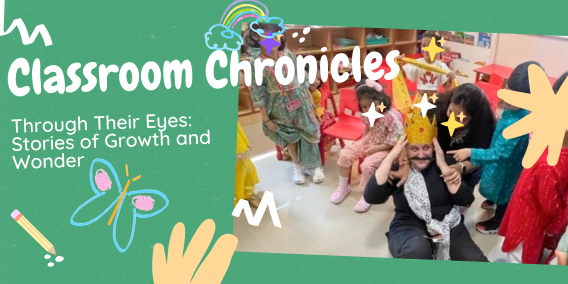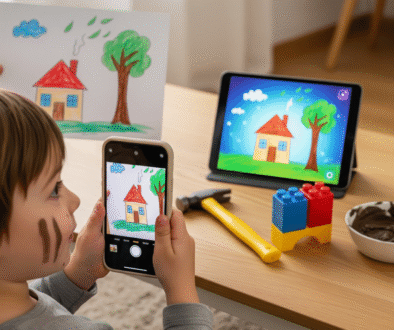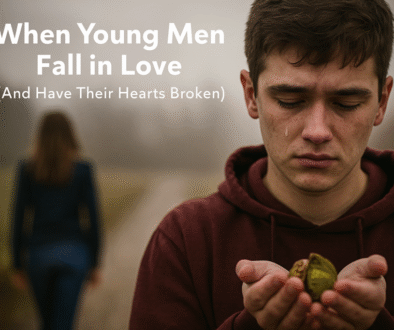
through their Eyes - from the teacher journal
Lessons from the Unfiltered World of Young Learners
Teaching young children is like opening a mystery book where every page surprises you. There’s no predictable plot, no fixed ending—just a whirlwind of questions, giggles, tantrums, and little moments that make you stop and think. Some days, it feels like a beautiful chaos; on others, it’s a crash course in patience. But every single day, it’s a reminder that teaching isn’t about shaping children into who we want them to be—it’s about learning who they already are.
Let me take a moment to share three heartfelt stories of little humans who have profoundly influenced my understanding of life and learning. Their insights have taught me lessons that no training or textbook ever could. While there are many more stories I long to share, today, I want to focus on these three, as they hold a special place in my heart.
The Writing Girl
She was the kind of student every teacher secretly dreams of. Polite, diligent, obedient—a child who made your job easier. When it came to our school’s rigid, perfection-driven system of weekly notebook checks, her work always sparkled. Five perfect lines of handwriting, no letters wandering off like lost sheep.
But one day, as we worked on another “perfect” page, she looked up and said, “Ma’am, I don’t want to write anymore.” Her voice was small, but her words felt enormous.
I paused. Forcing her to write would mean crushing her spark, but not meeting the school’s expectations? That was another kind of trouble. So I asked gently, “Alright, but when do you think you can finish this? Before lunch, or maybe tomorrow?” She thought for a moment and said, “Tomorrow.”
The next day, she came back ready to play, not write. Her energy was all about friendship and fun, not pencils and paper. And I let her be because, at that moment, her joy mattered more than any notebook.
My teaching partner didn’t agree. “But what if the principal finds out?” she hissed. And yes, the fear of being reprimanded was real. But education isn’t about ticking boxes; it’s about respecting a child’s pace. That little girl reminded me that rules should serve children, not the other way around.
The Boy Who Couldn’t Sit Still
He was the child everyone warned me about. “You’ll see,” they said with knowing smiles. And yes, I saw—running, crying, throwing things, and turning my lessons into chaos. Most days, he was sent to the corridor with the Didi, away from the “structured” classroom.
At first, I struggled with him. There were moments I wanted to yell, to demand stillness. But then he said something that broke my heart: “Ma’am, my hands and legs don’t listen to me. I tell them to stop, but they won’t.”
Imagine the frustration of being trapped in a body that won’t obey you. His “misbehaviour” wasn’t rebellion; it was a cry for help. And when he cried, he explained, “I’m angry because I’m crying, and I don’t want to cry.”
He didn’t need punishment; he needed space. He needed to run, to release his boundless energy, to feel heard. His life was a mix of school and waiting—waiting at the window for his father to come to pick him up, running faster than his small legs could carry him to greet him with a hug.
He taught me that behaviour is communication, and it’s up to us to listen. His wild energy wasn’t a problem; it was his language. And in those chaotic moments, I learned to meet him where he was, not where I wanted him to be.
The Silent Artist
She was the opposite of the restless boy—silent, calm, always in her corner. While others chattered and played, she drew. Beautiful, intricate pictures poured out of her tiny hands. But she never spoke, never answered questions, never raised her hand.
For weeks, we thought she had a speech delay. Then her mother shared a video that left us speechless. There she was at home, singing and dancing in high heels, a confident, vibrant child we had never seen in the classroom.
Her silence wasn’t a limitation; it was a choice. Maybe she didn’t feel the need to speak in class. Maybe she didn’t feel safe enough yet. Whatever it was, it wasn’t something to “fix.”
I stopped pushing. I let her art do the talking, and slowly, her confidence began to show—not in words but in the little things. She started to raise her hand more often, not to speak, but to share her drawings with the class. And as the days went on, I noticed something magical. She wasn’t just quiet anymore. She was finding ways to express herself. Her art wasn’t just her voice—it became a bridge to her world.
And then one day, she said, “Ma’am, I made this for you,” handing me a picture of the classroom with everyone smiling. It was her way of saying, “I’m here. I see you.”
What she taught me was profound: children express themselves in many ways, and sometimes silence is a tool for building connections. Her journey reminded me that the true language of teaching lies in understanding the unspoken and giving children the space to find their own voice, in their own time.
The Boy Who Wouldn’t Speak
He was one of the quietest children I had ever taught. While the other kids chatted, laughed, and played, he stayed silent. Not a single word, even when I gently encouraged him to speak. At first, I thought he was shy. But as the days turned into weeks, I realized this was something deeper.
His parents told me that at home, he talked endlessly—telling stories, asking questions, laughing. But in the classroom, it was as if he’d lost his voice. That’s when I learned about selective mutism. It wasn’t that he didn’t want to talk; he couldn’t.
This was a challenge I wasn’t prepared for, and honestly, I wasn’t sure what to do. My instincts told me not to judge or push him, but how could I connect with a child who couldn’t respond? Over time, I learned to adapt. I stopped asking him open-ended questions and started with simple ones—questions he could answer with a nod or a shake of his head. I avoided putting him on the spot or pressuring him to speak.
I learned to observe him carefully. His body language, his eyes, even his drawings—they all became his way of communicating. I made sure he felt included, even if he never spoke a word in class.
What surprised me the most was the change in his behavior once I stopped expecting him to talk. He began to relax, his eyes lit up more often, and he even started participating in group activities in his own quiet way.
What this experience taught me is that sometimes, silence isn’t about shyness or resistance—it’s a deeper form of communication. With selective mutism, the child’s inability to speak doesn’t come from a lack of willingness, but from an internal struggle that others may not see. I learned that patience and understanding are key. When you let go of the expectation for a child to speak and instead observe their other forms of expression—whether through their eyes, their body language, or their art—you begin to see a whole new world of communication.
The biggest lesson he taught me? Sometimes, the best way to help a child is simply to step back, observe, and let them lead the way. He showed me that silence isn’t an absence of communication; it’s another form of expression that requires patience and understanding.
The Drifting Boy
He was a star—a curious, brilliant child who soaked up everything like a sponge. His questions were endless, his imagination boundless. But one day, I noticed something was off. He seemed present but wasn’t really there. His answers didn’t match my questions, and his usual spark was dim.
Concerned, I decided to talk to his parents. His mother admitted she’d noticed the same thing and feared he might need professional help. I shared her worry but also felt a pang of guilt—was I overstepping?
A few days later, she called me with relief in her voice. He had an ear infection, something they’d never suspected. It was causing him pain and irritation, making it hard for him to concentrate. The medication worked, and soon, he was back to his lively self.
The experience taught me two things: trust your instincts and never hesitate to involve parents. Sometimes, our observations can make all the difference.
The Boy with the Marker
This boy had a wit that kept me on my toes. Once, I was drawing a story on the board—a river with a broken plane on one side and a pilot who needed to cross to the other. I asked the class, “How will he get across?”
The answers were delightful—build a boat, use magic shoes, wait for help. But this boy raised his hand, grinned, and said, “Ma’am, just use your marker and draw a bridge.”
I laughed so hard that I nearly dropped the marker. His response was a reminder that children see solutions where we see problems.
What They Taught Me
These children—each one so different, yet all alike in their own way—have changed me in ways I never anticipated. Teaching isn’t about controlling outcomes or fitting kids into moulds. It’s about understanding their unique hearts and minds, adapting to their needs, and creating space for them to simply be who they are. And through it all, I’ve learned that the best lessons don’t come from textbooks—they come from the little humans who walk into our classrooms every day, ready to show us their world.
The writing girl taught me the importance of respecting a child’s pace, a lesson in not forcing progress but allowing it to come when the child is ready. The restless boy reminded me that behaviour is often a cry for help, and that what we see as misbehaviour is sometimes just a louder expression of something deeper. The silent artist helped me understand that communication doesn’t always come in the form of words—sometimes, it comes in the quiet of a drawing, a look, or even a gesture. She reminded me that the unspoken can often say more than words ever could.
The drifting boy taught me to trust my instincts and that when something seems off, it’s worth exploring with parents and professionals. His lesson was about the power of collaboration and being willing to step in when something doesn’t feel right. And the boy with the marker? He reminded me to laugh, to embrace the unexpected, and see the world through the eyes of a child—where solutions are simple, yet imaginative.
And then there was the boy who wouldn’t speak. His silence was a lesson I hadn’t anticipated, but one I desperately needed to learn. At first, I struggled to understand. Why wasn’t he speaking? Was he just shy? But as I learned about selective mutism, I realized his silence was not a rejection of the world around him; it was a way of speaking that only those willing to listen closely could understand. I learned that silence isn’t the absence of communication—it’s a different language, one that requires patience, understanding, and the courage to let go of assumptions. His experience taught me that the most important thing we can do for a child is to meet them where they are, without judgment, and allow them the space to find their voice in their own time.
Through all these children, I’ve learned that teaching isn’t about having all the answers—it’s about being open, flexible, and willing to learn alongside your students. They’ve taught me to trust in the process, to give them the room to be themselves, and to listen in ways I never thought possible. Every day in the classroom is a new lesson, and I am forever grateful for the wisdom these little ones have shared with me.


